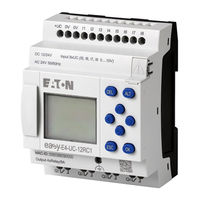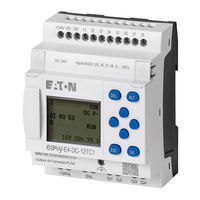Eaton EASY-E4-DC-12TCX1 Manuals
Manuals and User Guides for Eaton EASY-E4-DC-12TCX1. We have 2 Eaton EASY-E4-DC-12TCX1 manuals available for free PDF download: Manual, Instruction Leaflet
Eaton EASY-E4-DC-12TCX1 Manual (622 pages)
Table of Contents
-
Imprint2
-
-
-
-
Temperatures42
-
System Test53
-
Memory Card66
-
Ethernet68
-
-
Licensing71
-
-
Switch on80
-
-
LCD Display91
-
Keyboard92
-
-
4 Operation
91-
Main Menu99
-
Menu Parameter100
-
Set Clock Menu101
-
Menu Card102
-
Menu Information103
-
Program Menu106
-
-
Delete Program117
-
-
Function Blocks128
-
Relays128
-
Contacts129
-
Coils130
-
-
Got to a Rung144
-
-
Jumps148
-
PROGRAMS Submenu156
-
Start Program156
-
Card - Device157
-
Device - Card157
-
-
-
PARAMETERS Menu164
-
-
-
Parameterization185
-
T - Timing Relay199
-
Signal Diagrams203
-
Retention211
-
-
-
AR - Arithmetic254
-
CP – Comparator259
-
Scan Time Tc279
-
Normal Mode291
-
Jog Frequency PF298
-
Level Control305
-
D - Text Display361
-
Text Display Tab363
-
Display Priority364
-
Rolling Time364
-
Alarm364
-
Languages Tab365
-
Type and Operand366
-
Value Display372
-
Bar Graph373
-
Static Text374
-
Running Text374
-
Rolling Text375
-
Message Text376
-
Value Entry379
-
Latching Button381
-
DL - Data Logger384
-
Storage Mode387
-
Sample Log File388
-
LB - Jump Label395
-
BCD Mode402
-
BIN Mode402
-
Name and Version439
-
Retention Bytes442
-
Coil Tab447
-
System Settings463
-
View465
-
Device ID465
-
Boot Logo466
-
Net467
-
Bus Delay467
-
Remote RUN468
-
Switch Languages469
-
Debounce473
-
P Buttons475
-
DST Setting DST486
-
Net-Group488
-
Transfer Program493
-
The Unit Inside505
-
Operating States516
-
Powered up516
-
NET Network517
-
Clock532
-
Display532
-
Wiring Test535
-
Setting up a NET541
-
NET - a Group541
-
Between Groups541
-
NET Settings545
-
NET Group546
-
Net-ID546
-
Modbus TCP549
-
Read Coils 0X01551
-
Modbus Map561
-
E-Mail Function566
-
Faults571
-
Event574
-
Technical Data588
-
Glossary615
-
Advertisement

